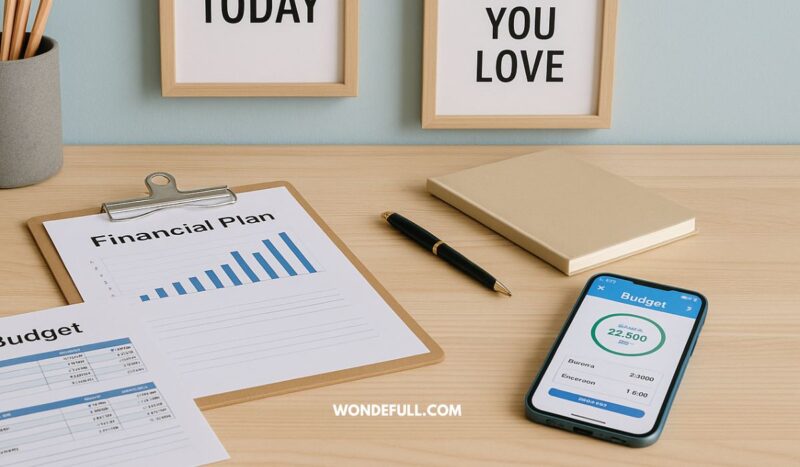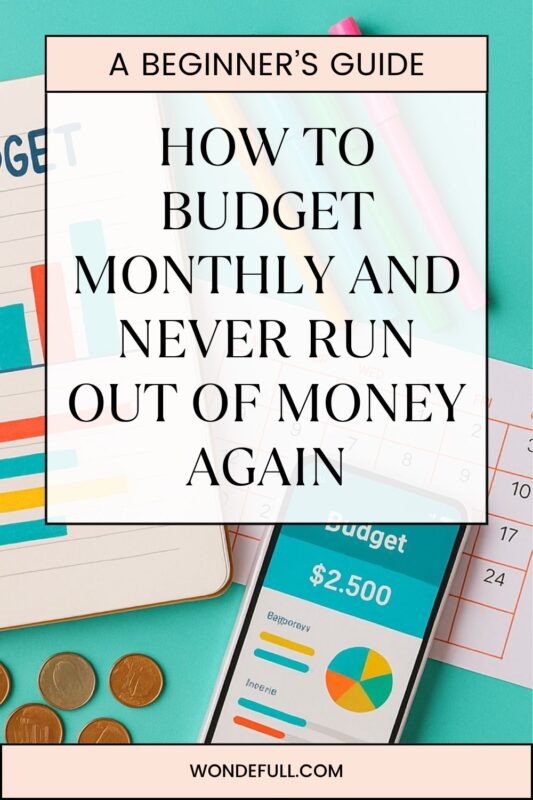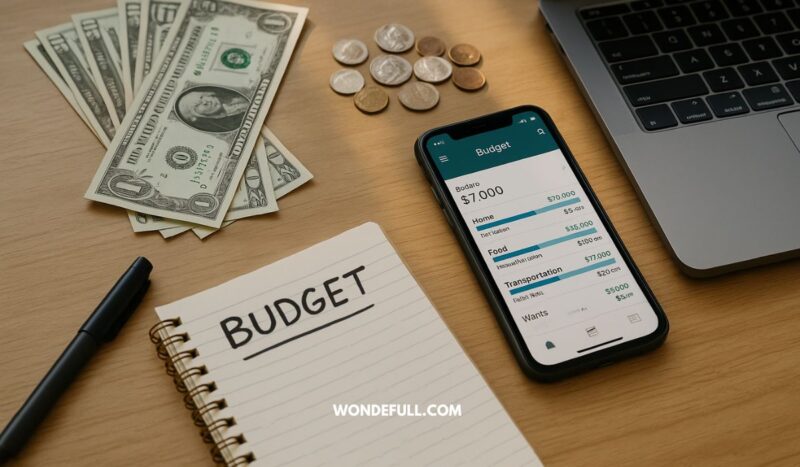Learning how to budget has never felt so doable. I’ll walk you through the methodology, a practical step-by-step guide, budgeting tool recommendations, along with my stories to transform your approach to money management.
What is Budgeting?
A budget, at its core, is a financial roadmap that outlines how you plan to allocate your money for different purposes over a specific period. It serves as both a mirror reflecting your current financial situation and a compass leading you toward your financial goals.
For many, the idea of budgeting is overwhelming. That’s why it’s crucial to adopt the right mindset from the beginning.
The Important Mindset for Budgeting Success
Many people feel anxious when they hear the word “budget.” It sounds restrictive, like a strict teacher scolding you for spending money.
But what if you saw your budget as a coach instead?
Someone who’s on your side, showing you where your money is going, helping you prepare for unexpected expenses, and cheering you on as you move toward your savings goals.
This mindset shift, from restriction to empowerment, will boost your success with budgeting tremendously!
Imagine the confidence you will gain when you know where your money goes and can save for emergencies and future purposes. That’s a liberating and powerful moment!
The Powerful Tool: Zero-Based Budgeting Envelope System
Zero-Based Budgeting
- Concept: Every month or following your paycheck cycle, allocate every dollar of your income to a specific purpose, such as rent, groceries, savings, or debt payments.
- Focus: It emphasizes intentional spending by requiring you to justify each expense.
- Benefit: Helps you identify areas where you might be overspending and make conscious decisions about where your money goes.
Envelope System
- Concept: You divide your cash into physical or digital envelopes, each labeled with a specific spending category.
- Focus: You only spend the money allocated to that specific envelope for that category.
- Benefit: Helps control spending by limiting you to the amount you’ve allocated for each category, preventing overspending.
When you bring these two principles together, you get a powerful financial management tool: zero-sum budgeting envelope system!
This system will help you manage money where every dollar is intentionally allocated, and spending stays within clearly defined limits. It’s a simple yet powerful way to improve your financial clarity, and taking control of your finances.
Let me share a personal experience to illustrate this transformation. Since 2016, I started recording my expenses using Money Lover. Just to know where my money went each month, but it wasn’t comprehensive as I did not include investments, revenue and cost from my projects. And I had only a simple budgeting on fashion and beauty, meals, and sports. So, I did not have a full picture of my financial situation. When my income increased, I spent more, now knowing how to save and plan for future.
It was until 2024 where I was in my late 20s, I experienced burnout from work and realized that climbing corporate ladder can only get more challenging as I age. I have to plan my finances well that I could retire and maybe an early retirement. That’s how I got started on investment and zero-based budgeting envelope system.
Money Lover was just a simple inflow and outflow tracker, so I tried YNAB for a month but the subscription fee was too expensive for me, so I decided to create my own zero-based budgeting envelope budgeting template. I took the time to create my first budget, I could feel the weight beginning to lift off my shoulders. The act of organizing my financial life gave me a clear understanding of my income, fixed expenses, savings, and uneccessary spending.
Suddenly, I could see, for the first time, my savings were depleting. My total outflow, including emergency fund contributions and investments, was exceeding my income. Hence, I cut back expenses on some areas. With every line item I adjusted, I felt increasingly in control.
The psychological benefits of budgeting are profound. Knowing that I had a plan in place meant that I could confront financial emergencies without the panic that had previously accompanied them. This newfound clarity also inspired me to set and achieve more ambitious financial goals, such as spending for personal development purposes, doing charity, spending for my loved ones, and saving for a vacation. Instead of feeling confined by my finances, I felt liberated.
Lastly, budgeting forced me to become more financially literate. I’ve learned to identify needs versus wants, the importance of saving for emergencies, and the value of investing in my future. By the end of each month, I would revisit my budget, tracking my spending against my budget and making necessary adjustments. This active engagement with my finances transformed what once felt overwhelming into a rewarding challenge. It gave me confidence to dream bigger financial goals. Major life goals, like planning a wedding or building a family finally feel possible!
Step 1: Gathering Your Financial Facts
To embark on the journey towards financial freedom through effective budgeting, the first essential step is to gather all necessary financial facts. This process involves compiling a comprehensive snapshot of your current financial situation, including the following details:
- Your total monthly income (after tax)
- Your cash, savings, investment, debts, and other accounts balance
- Your expenses by categories
Start with your payslips and statements that capture all your incomes. For example, full-time job salary, rental income, freelance or project income, and second-hand items sale. Note down your monthly income.
Then look into all your financial accounts (cash, savings, investment, and debt) and record the account balances.
Next, focus on expenses. Start by gathering bank and e-wallet statements from the past few months. These statements will typically encompass all transactions, including direct debits, credit card bills, and any recurring payments such as loans. It’s important to categorize these expenses. Do take note of one-off, less frequent expenses such as charity, gifts, and travel. These often fly under the rada but can derail your budget if not accounted for.
Finally, keep them somewhere secure. I keep them both digitally on Google Drive and physically in folders. When initiating your budget, having organized documentation at your fingertips will significantly streamline the setup process.
Step 2: Utilizing Tools and Apps
Here are a few budgeting tools that use zero-based budgeting envelope system and support desktop and mobile access:
- YNAB (Web, App): You Need A Budget is the OG tool, which embodies the proactive budgeting philosophy that emphasizes giving every dollar a job. However, the subscription fee has increased a lot.
🌟Best for: Users who want automation, bank syncing, and detailed reports
💸Pricing: $14.99 per month or $109 annually. - Actual Budget (Web, App): An open-source budgeting tool that follows the zero-based envelope model. It requires self-hosting, which gives you full control over your data but may need some technical setup.
🌟Best for: Tech-savvy users who want control and privacy
💸Pricing: $1-2 per month for self-hosting - Goodbudget (Web, App): The rising app as YNAB is getting more expensive.
🌟Best for: Users looking for mobile-first budgeting with envelope logic
💸Pricing: $10 per month or $80 annually. - EveryDollar (Web, App): Another compelling tool created by financial guru Dave Ramsey. It only supports United States.
🌟Best for: U.S.-based users
💸Pricing: $17.99/month or $79.99/year (Premium only) - Create your own spreadsheet
🌟Best for: Budgeters who want control without a subscription
💸Pricing: FREE - Budget Spreadsheet (Google Sheets): This is the budgeting template I personally built and refined through years of real-world experience. It includes features that reflect how I actually budget, and it’s beginner-friendly too.
🌟Best for: Anyone wanting an affordable, proven, and simple solution
💸Pricing: $8–9 (lifetime access and updates)
Regardless of the method you choose, the key is consistency. Regularly inputting data and reviewing it ensures that your records remain current and precise.

Step 3: Setting Up Your Budget
Setting up your budget is a crucial step toward achieving financial freedom, especially after gathering your financial facts. It involves taking the raw data you’ve collected and transforming it into a structured plan that reflects your financial goals and lifestyle. To create a budget from scratch, you will need to categorize your expenses and decide on a budgeting approach that suits your needs.
To begin, categorizing your expenses through two lenses:
1. Categorize by Frequency
This helps you spot patterns and prepare for timing-related cash flow issues.
- 🧾 Fixed Monthly Expenses
These are recurring payments you expect every month—stable and predictable.
Examples: Rent, insurance, subscriptions, phone bills, loan payments - 📅 Irregular or One-Off Expenses
These are occasional or seasonal costs that don’t happen monthly, but still need planning.
Examples: Gifts, travel, medical bills, tech upgrades, car servicing
2. Categorize by Priority
This gives your spending intention, helping you align money with your values and goals. The examples below are just for reference as everyone’s priority is different.
- ✔ Essentials
The absolute must-haves that keep life going.
Examples: Rent, utilities, groceries, transport - 🔁 Needs & Goals
These aren’t urgent, but they are important for long-term growth and stability.
Examples: Investments, savings, career expenses, health insurance - 🎉 Wants
Flexible, feel-good spending that enhances your lifestyle.
Examples: Dining out, shopping, hobbies, entertainment, gifts
Here are the examples using both dimensions
- “Spotify Subscription” → Fixed Monthly + Want
- “Online Course Fee” → One-Off + Need
- “Groceries” → Fixed Monthly + Essential
With this dual approach, you can see what costs are truly necessary, what can be adjusted when money is tight, and assess whether the spending aligns with your values vs. what’s just habit.
Once you have your expenses all lined out and categorized, you can input them into your chosen budgeting tool. Most tools allow you to create custom categories that match the two-dimensional breakdown described above.
When it comes to deciding how much to budget, it takes trial and error. The rule of thumb: at least 20% for savings, and spend less than you earn. With a zero-based budget, your income minus your budgeted expenses should equal zero.
In summary, establishing a budget involves strategically categorizing your expenses, selecting an appropriate tool, and understanding your financial priorities. As you build your budget from the ground up, this foundational step will empower you to take charge of your financial journey.
Step 4: Tracking and Adjusting Your Spending
To effectively manage a budget, you must be consistent in tracking and adjusting your spending. This is not merely an exercise to tally numbers. It’s about owning your spending decisions, understanding where your money flows, and steering it toward your financial goals.
With the budgeting tool you selected from step 2, you can either maintain your spending log manually or link your bank account to automatically sync your transactions to the budgeting tool. Even if you opt for the automated way, it is crucial to review the data weekly or monthly. This helps you catch overspending early and make informed adjustments before it snowballs.
Life is unpredictable, and unexpected events can derail even the most meticulously planned financial strategies. For example, I lost my phone that I just bought, and now I have to pay double the installment for the old and new phones. Such an incident requires me to shift the budget from elsewhere, which I could cut down on the spending. I ended up stopping shopping for new clothes for months to ease the cash flow. If you want a proactive approach, set aside some money each month for unexpected events. This buffer can make a difference when life throws you a curveball, like car repairs, lost items, or medical bills, without derailing your day-to-day life.
Another common budgeting pitfall is emotional spending. Emotional spending occurs when individuals attempt to cope with stress or negative emotions by indulging in items that provide short-term gratification. For example, people bought a spa package to relieve stress even though it was beyond their paychecks. Or it could be the new luxury bag you bought because it was on sale, only to find it too heavy or impractical. When you track your spending and review regularly, it’s easy to catch this emotional spending pattern. Over time, you will be aware of the triggers and opt for healthier coping mechanisms, such as exercise or hobbies that don’t cost much.

Another pitfall is the tendency to ignore budget categories that seem small or irregular. Little things add up quickly, and these can create significant financial strain over time. It’s common for people to overlook how much they spend on coffee, snacks, or subscriptions. In my case, I discovered that my sports-related expenses took a significant percentage of my monthly income. The event’s fees, equipment, and outfits are not small purchases. With this realization, I had to move the budget from elsewhere and be more cautious about my spending.
Ultimately, budgeting is not a one-time task; it is an ongoing process that adapts as life unfolds. Your discipline will lead you to a fruitful reward of financial control and mindfulness in spending!
Step 5: Maintaining and Growing Your Financial Health
This budgeting system is not just about tracking and controlling your spending. It’s about having a working system that fosters healthy financial habits, which allow you to build a secure financial feature.
Here are the principles/habits that can help you grow your financial health:
- Regular reviews. Whether your aspirations are saving for a dream home, paying off student loans, or aiming for FIRE, reflecting on your progress and recalibrating your budget is essential. Whenever you are making bill payments each month, use that period to analyze your spending, savings, and investments and see how you can adjust to align them with your financial objectives. I always create graphs or charts to visualize my goals process and keep myself motivated.
- Be adaptable. As life changes, so do your financial responsibilities. Don’t be too hard on yourself when a crisis arises and your savings deplete. If you make a spending or investment mistake, just recalibrate and move on.
- Living below your means and saving for an emergency. Savings play a crucial role in expanding your financial health. Aim to establish an emergency fund that covers three to six months’ worth of living expenses. This safety net can provide peace of mind and prevent financial derailment during unexpected situations.
- Learn about investment and start investing. If you are a starter, you might want to take Warren Buffett’s advice: Research low-cost index funds and deposit money regularly into them. If you have a higher risk appetite, you can explore stocks and crypto. Beware of the derivatives and leverage. As someone who has experienced a few market crashes, here are my learnings:
- Don’t blindly follow others’ suggestions. Do your homework.
- Don’t let emotions cloud your decisions, or you will panic sell easily.
- Always have a stop loss, especially it is a risky investment.
- Holding less stocks and making fewer trades earn more money.
- Always have bullets so that you can secure the bargain when market crashes
- Educate yourself. The financial landscape evolves rapidly, so keeping yourself informed about investment opportunities, macroeconomy, and personal finance knowledge can enable better decision-making. There are many personal finance content creators out there, just have to be careful about those fake investment gurus.
- Celebration of success. Emotional factors also play a vital role in keeping you motivated to achieve financial goals. Rewarding yourself with items or experiences that enhance your quality of life when you reach a milestone can reinforce the positive behavior change associated with budgeting. This balance between discipline and reward ensures you remain motivated on your journey toward financial freedom.
Conclusion
Effective budgeting opens doors to financial freedom and security. Now that you’ve learned how to budget the right way, you’re set on a path of financial empowerment and success.
Share it on Pinterest – thank you!

